San Francisco’s nationally recognized SPUR organization has some innovative solutions on how to make pricey San Francisco affordable again. These ideas (some tried & true and some out of the box) have the power to make the city even more of a success story!
- Protect the existing rent controlled housing stock.
- Reinvest in public housing.
- Double the amount of subsidized affordable housing.
- Make it much easier to add supply at all levels.
- Launch a wave of experiments to produce middle-income housing.
- Use new property taxes from growing neighborhoods to fund improvements to those Neighborhoods
- Reinvest in the transportation system, as a way to provide viable transit options and reduce household transportation costs
- Raise the minimum wage
Read SPUR’s full report here about their recommendations for improvement.
Read more »
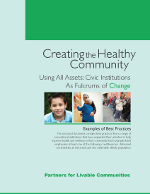
Partners compiled a collection of best practices of traditional community institutions incorporating health and wellness into their agenda and programming to improve community health. The best practices focus on improving the health of at least one of three constituencies: distressed communities, at-risk youth, and the vulnerable elderly.
Examples of institutions include arts and culture organizations, botanical gardens, community development corporations (CDCs), faith-based organizations, libraries, museums, public markets, and zoos.
Click here to download Creating the Healthy Community - Using All Assets: Institutions as Fulcrums of Change
Read more »
Terms:Aging, Community Building, Community Development, Community Engagement, Creating The Healthy Community, Cultural Institutions, Health & Wellness, Healthy Communities, Institutions as Fulcrums of Change , Intergenerational, Libraries, Program Areas, Public Health
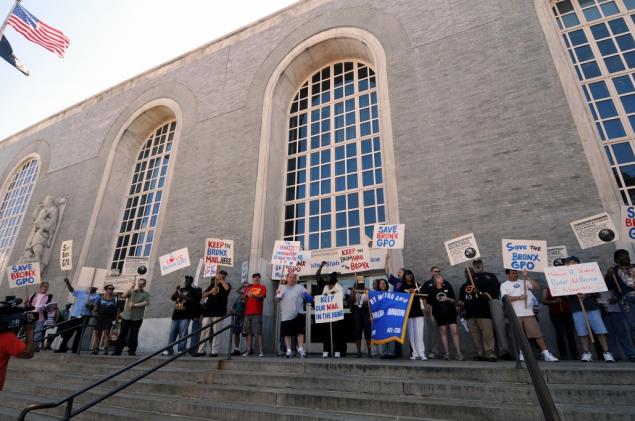 An article published in the Washington Post earlier this week highlights the dramatic decline of the United States Postal Service and the financial difficulty that it is facing today. Since the passing of the Postal Accountability and Enhancement Act (PAEA) in 2006, the postal service has started running massive deficits has been forced to lay off tens of thousands of workers. To remedy this financial mess, the USPS has increasingly started to sell historic Post Office buildings, often centrally located on valuable tracts of land, to raise money. An article published in the Washington Post earlier this week highlights the dramatic decline of the United States Postal Service and the financial difficulty that it is facing today. Since the passing of the Postal Accountability and Enhancement Act (PAEA) in 2006, the postal service has started running massive deficits has been forced to lay off tens of thousands of workers. To remedy this financial mess, the USPS has increasingly started to sell historic Post Office buildings, often centrally located on valuable tracts of land, to raise money.
Read more »
On Thursday, the National League of Cities released The 10 Critical Imperatives Facing Cities in 2014, its annual report highlighting ten of the most pressing issues facing cities across the United States. Partners board member and incoming NLC President, Salt Lake City Mayor Ralph Becker explained during the report's unveiling, "This is not a wish list just of cities. This is a wish list of the people who live in America. That’s 80 percent of the population of America that’s being represented through us."
The ten items on the list were:
- Fragile Fiscal Health
- Deteriorating Transportation Infrastructure
- The Shrinking Middle Class
- Inadequate Access to Higher Education
- The Need for Affordable Housing
- A Less-Than-Welcoming Return for Veterans
- Gang Violence
- A Broken Immigration System
- Climate Change and Extreme Weather
- Lack of Public Trust
Click here to read the full report from NLC, which includes an overview of initiatives being taken by cities in their own efforts to tackle these ten challenges and create more livable communities for their residents.
Read more »
Terms:Community Building, Community Development, Downtown Development, Economic Development, Education, Environment, Health & Wellness, Housing, Immigration, Neighborhood Revitalization, Other Reports/Publications, Placemaking, Public-Private Partnerships, Transportation, Urban

Last month the nonprofit group America Achieves released a report titled Geek Cities: How Smarter Use of Data and Evidence Can Improve Lives through their Results for America initiative with support from Bloomberg Philanthropies. The report dissects how leaders in six major cities throughout the United States (and one initiative in London) are using data and technology to improve the lives of their residents. Rapidly improving technology and the digitalization of information has made mass data collection easier than ever, and cities are using this data to find effective programs and measures to combat social, economic, and physical challenges that many face today.
Read more »

For residents of Chicago’s northern suburbs, the Chicago Botanic Garden is much more than just a collection of colorful plants and flowers. Since it opened more than 40 years ago, the 385 acre grounds have served as an important center for community activity and education. The Garden is home to 26 separate gardens and four natural areas, as well as a conservation science education center and a library with one of the country’s largest collections of botanical books. The grounds are also host to numerous community events and educational courses throughout the year.
Read more »
Terms:Arts & Culture, Chicago, IL, Community Development, Creative Economy, Cultural Institutions, Design, Environment, IFC Best Practice, Institutions as Fulcrums of Change , Parks, Playgrounds & Gardens
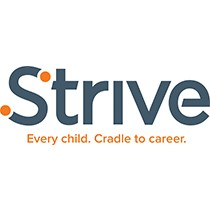
The Strive Partnership is an effort launched by community leaders in the Cincinnati region in 2006 that relies on innovative strategies to improve student education outcomes. The Partnership has designed a strategic approach to education reform that can be applied to communities throughout the country. The approach relies on a collaborative effort from community stakeholders from all sectors of the economy to encourage learning and development beyond the walls of their schools.
Read more »
Each year a number of organizations and publications, from the New York Post to The Economist and Bloomberg Businessweek, devise a list of the most ‘livable’ cities in America and the world. Then, without fail, every year, waves of critics denounce the list for being biased towards certain cities. This process illustrates how truly difficult it is come up with a singular definition of the term ‘livability’. Each publication has their own formula that generally includes ratings that represent each city’s access to affordable housing, cost of living, quality of education, and amount of cultural amenities, among the many other components that determine a city’s livability. How these factors are weighted in the formula depends on the interests and goals of the publication.
Read more »
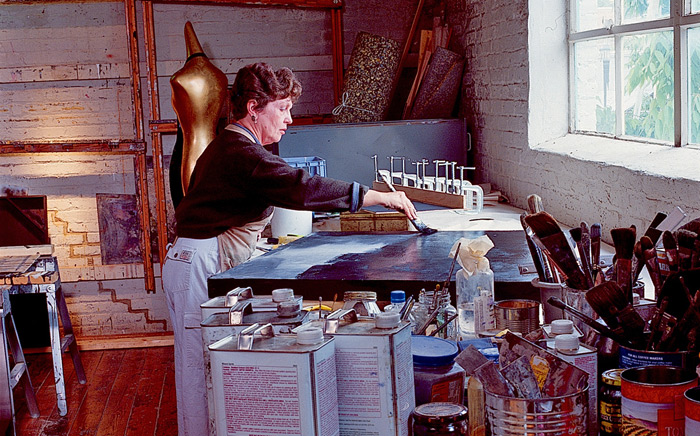
ArtSpace is a national organization, headquartered in Minneapolis, which works to transform communities through the arts. The organization runs 33 affordable, artist-housing facilities throughout the country, in both urban and rural areas, that help improve the livability of their neighborhoods by repurposing old or abandoned buildings to attract artists to live and work in the community.
Read more »
Inner-city Detriot may not be the first place one thinks of when looking to learn golf, but that is precisely where Renee Fluker founded her immensley successful Midnight Golf Program a dozen years ago. The program is a 30 week mentoring experience that not only teaches students about golf, but also about a number of essential life skills. The organization uses golf as a medium to teach children important life lessons, such as strategic thinking and how to deal with frustration and failure.
Read more »
 Photo Credit: Alan Rosenblum Photo Credit: Alan Rosenblum
Courtesy of Estudio Teddy Cruz
Home to the nation’s busiest United States-Mexico border crossing, San Ysidro is a suburb of San Diego, California, that lies just north of Tijuana, Mexico. Comprising mostly third- to first- generation immigrants, San Ysidro is often ignored, viewed as a place to pass through on the way to and from the border. Many San Ysidro-Tijuana families live in a bi-national condition, a state of being that finds families, work, education, affordable housing, health care, and economies tied to one another, and one that is currently struggling with the hot spots of drug cartel violence. Casa Familiar, a San Ysidro-based nonprofit organization, is working to invigorate the community by advocating for and assisting the residents in such areas as immigration services, education, and job placement[i].
Lyz Crane draws on the work of practitioners and researchers to characterize the field of arts-based community development in which arts and culture can help achieve place based change related to the physical, social, and economic dimensions of place. This paper examines the premise that the existence of arts is considered a powerful end in itself, Crane then outlines the variety of ways that the actors and activities involved in arts and community development work can relate to and interact with each other to create sustainable communities. Looking at the cultural ecology of place, creative economy development focuses on fostering local creative businesses and supporting creative workers both in the arts and in supporting industries while cultural development may focus on preserving cultural assets—traditions, language, stories—or on building on them to create stronger, more connected communities. There is also a complex community development ecosystem of organizations, interests, and tools. Stakeholders may involve arts in their agendas, create arts programming, provide or develop arts spaces, employ artists, and/or partner with arts organizations. Indeed, both the arts and community development are part of the same ecosystem and all of these 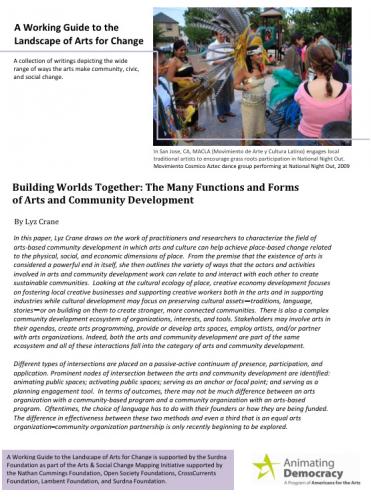 interactions fall into the category of arts and community development. interactions fall into the category of arts and community development.
Crane places different types of intersections on a passive-active continuum of presence, participation, and application. Prominent nodes of intersection between the arts and community development are identified: animating public spaces; activating public spaces; serving as an anchor or focal point; and serving as a planning engagement tool. Crane points out that, in terms of outcomes, there may not be much difference between an arts organization with a community-based program and a community organization with an arts-based program. Oftentimes, the choice of language has to do with their founders or how they are being funded. The difference in effectiveness between these two methods and even a third that is an equal arts organization–community organization partnership is only recently beginning to be explored.
Click here to download the whole document.
Read more »
Terms:2012, Arts & Culture, Business, CBC Report/Publication, Community Building, Community Development, Community Engagement, Creative Economy, Cultural Institutions, Featured, Other Reports/Publications, Placemaking, Public Art, Public-Private Partnerships
 photo credit Project SHINE photo credit Project SHINE
“When I first came to America, I only knew a couple letters. I couldn't communicate with anybody. And I learned about this program and I started (to learn English). I have been here for three years and now I have built a basic vocabulary that I can carry my daily life. It basically helped me to live in America." -Project SHINE participant
In the early 1980s, Nancy Henkin, founder and director of the Intergenerational Center at Temple University, was shocked by the news that loneliness and social isolation led an elderly Asian woman to commit suicide, at a time when it was commonly assumed that older immigrants were part of tight-knit and supportive communities. Henkin realized that older immigrants often struggle with language barriers, changes in customs, and differences in social roles more than their younger counterparts, and began working to establish a program that could support them. Project SHINE was launched in 1985, to reach out and provide aging immigrants with language and cultural resources to help them adapt in their new community.
Read more »
Terms:2012, Aging, Aging in Place, AIP Best Practice, City Leaders Institute on Aging in Place, Community Development, Community Engagement, Education, Faith Community, Families, Health & Wellness, Heritage, Immigration, Intergenerational, Jobs, Life-Long Learning, Multicultural, National, Youth
 Partners for Livable Communities presents a PowerPoint presentation to accompany the 2012 Stories for Change report. This presentation is for community residents, city leaders, arts and cultural institutions, and many more to share the great stories of innovation and creativity featured in the Stories for Change report to begin discussions of reaching out to older adults and immigrants with the community. Partners for Livable Communities presents a PowerPoint presentation to accompany the 2012 Stories for Change report. This presentation is for community residents, city leaders, arts and cultural institutions, and many more to share the great stories of innovation and creativity featured in the Stories for Change report to begin discussions of reaching out to older adults and immigrants with the community.
Read more »
Investors in America Award
Janet W. Thompson is honored for her expertise in community development, engagement, and reinvestment in nonprofit and financial management. As Interim President and Chief Executive Officer of the Nonprofit Finance Fund, community consultant to Morgan Stanley, and former Corporate Directorof Community Reinvestment at Citibank, her spirit and leadership has propelled public and private community engagement for more than 35 years.
Read more »
Founders Award for Civic Leadership
James O. Gibson is honored for his leading advocacy in urban revitalization, community development, and race relations. His demonstrated commitment to social equity for more than three decades on issues ranging from civil rights to economic opportunity has provided critical progress for our country’s social fabric.
Read more »
Entrepreneurial American Leadership Award
Robert Pohlman is honored for his foundational advocacy as the Executive Director of the Coalition for Nonprofit Housing and Economic Development. His influential support of the Housing Production Trust Fund and leadership has provided critical construction, rehabilitation, and acquisition of affordable housing units in Washington, D.C. during the past 10 years.
Read more »
Entrepreneurial American Leadership Award
Richard C.D. Fleming is honored for his commitment to building livable and sustainable cities as a civic entrepreneur for more than 30 years while engaged in private sector and civic initiatives to revitalize cities and metropolitan communities in Atlanta, Denver, and, for the past 17 years, St. Louis.
Read more »
Terms:2011, Awards, Board, Chamber of Commerce, Community Development, Community Engagement, Downtown Development, Economic Development, St. Louis, MO, Visioning & Planning
Investors in America Award
Ron Grzywinski is honored for his support of community reinvestment as co-founder of ShoreBank Corporation, a bank holding company that provided capital, credit, and management assistance to minority-owned businesses and families. His passion to require banks to meet the credit needs of their local communities became a catalyst of social change and renewal in America.
Read more »
There is a new buzz word in the battle against urban decline and vacant retail space—“pop-ups.” Simply put, a pop-up is a short term use of a retail space. Sometimes they come in the form of holiday stores, which close down after the season, while Target and other large retailers use them to promote specific products or lines. Urban development initiatives, however, have begun to use pop-ups as a tool to reinvigorate declining shopping districts and main streets by changing perceptions of the neighborhoods they open in and demonstrating to potential investors and entrepreneurs the value of investing in these communities.
Read more »
|
|